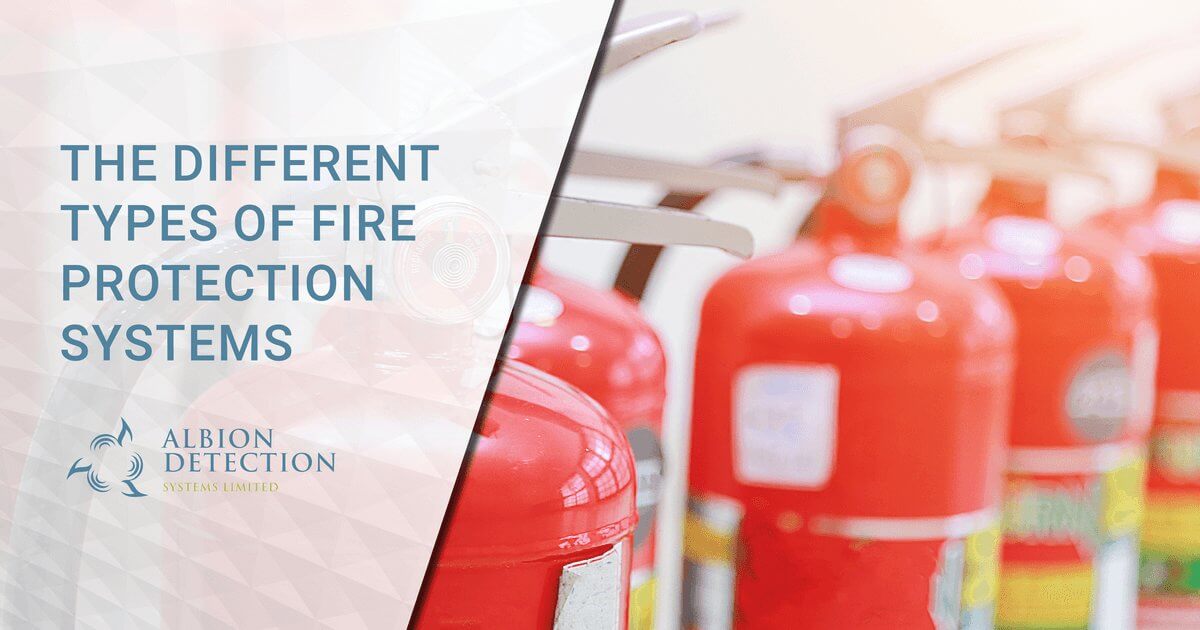
The Different Types of Fire Protection Systems – Albion Detection Systems
Fire protection systems are a must for every business premises, but understanding which systems are out there, and which ones would be best suited to your business, can be a tricky thing to master.
In this guide, we’ll show you a little about each of the main types of fire protection system, with recommendations for how best to implement both.
Fire Extinguishers
Fire extinguishers are a tried and tested method of fighting a fire on the first contact.
They’re particularly useful for smaller blazes and preventing the spread of fire before it catches hold.
Businesses both large and small benefit from installing fire extinguishers around their premises, and having basic measures in place such as this also ensures compliance with fire safety regulations.
Choosing the right one for your needs is vital, as is ensuring the correct fire protection installation for limited complications with practical use.
There are many extinguishing products available, such as
- Fire blankets designed from fire-resistant materials,
- Fire buckets (filled with water)
- Fire hose, most commonly found in larger commercial premises.
These options are useful for their portability, and best suited to very small fires at first point of contact.
However, they pose a serious risk to life if used on electrical fires, and should never replace more effective fire protection measures such as cylindrical fire extinguishers.
Instead only being used as a last resort when no other measures are immediately available.
The main forms of extinguishing fire protection come in five types, each suited to tackling different forms of fire:
- Water Fire Extinguishers
This variety of fire extinguisher is perfect for fires involving organic materials and solids such as
- Wood
- Cloth
- Paper
- Plastic
- Coal
They must never be used on electrical fires or those involving burning oils or chemicals.
The water in these extinguishers works to cool the ignition surface, reducing the burning rate.
Water fire extinguishers are available with either a jet or spray nozzle, or provide a pressurised water mist, allowing them to extinguish more efficiently in different environments.

- Co2 Fire Extinguishers
These fire extinguishers are mainly used for dealing with fires involving live electrical equipment, and care must be taken during use that the fumes do not asphyxiate those in smaller spaces.
The extinguishers are not suited to smaller fires and care must be taken to avoid reignition, though they can effectively ‘suffocate’ the fire in the first instance.
- Foam Fire Extinguishers
These are ideal for use on solid materials and burning liquids, including petrol and paint, as well as electrical fires.
Foam fire extinguishers work by breaking down interactions between the flame and the fuel powering the burning liquid.
Care should be taken to adhere to a 1m distance from sources of fire whilst in use.
- Powder Fire Extinguishers
Powder fire extinguishers offer a multi-purpose function, allowing them to be used on fires which involve organic materials and also gas fires.
They are safe to use on electrical equipment, though their usage may only cool the fire rather than prevent reignition altogether.
They should not be used for smaller fires such as those in kitchen environments, and are not recommended for use in enclosed spaces due to the possibility of impairing vision during use.
- Wet Chemical Fire Extinguishers
These fire extinguishers are best suited to fires involving cooking oils, though should not be used for some other causes of fire, such as petrol.
The chemical fire extinguisher works in a similar way to a foam fire extinguisher and has some of the same limitations.
Fire Alarm Systems
Fire alarms are often the first line of defence against fire in buildings both commercial and domestic.
By detecting signs of smoke, changes in the atmosphere or sources of heat, a quality fire alarm can help buy you time to evacuate the building and put your emergency fire safety plan into effect.
- Conventional Fire Alarms
Basic fire alarm systems remain a popular choice, with sound activation which alerts anyone in the building to the presence of fire.
- Smoke Detectors
These will alert your building to the first sign of smoke and are available in varying strengths to provide the level of defence your building needs.
- Wireless Fire Alarms
This high-tech solution offers an added layer of protection by linking your alarm to other security measures such as your individual address or even the zone where there is a fire.
Fire Sprinklers & Dampers
Fire sprinklers and dampers can help to put out fires in the first instance, sparing both your building and everyone inside from battling the blaze.
Not only can these systems limit the structural damage, they can also limit the spread of smoke making them a very useful form of fire protection.
Several high-profile cases have brought to light how important sprinkler systems can be to ensure adequate fire suppression, and the latest designs can be linked to your fire alarm system to provide crucial back-up should the need arise.
Ensure you carry out a full assessment prior to installation to ensure the best and most cost-effective sprinkler system for your building.
Emergency Lighting Systems
The lighting system is often one of the first things to fail in the event of a fire.
This puts emergency lighting as a critical component in ensuring your fire escape routes regulation is adequately met and your building can be evacuated quickly, calmly and safely.
There are many different types of emergency lighting available, from
- Slim-line and ceiling mounted lights (ideal for office spaces)
- To those which serve a more decorative purpose as well as being functional, providing a subtle line of defence or even weather-proof durability.
Fire Safety Signage
This is a simple and no-fuss way to help guide those in your building through your own fire safety procedures, and help them find the appropriate exits should an emergency occur.
Illuminated ‘Emergency Exit’ signs are a must in commercial buildings, as are signs positioned close to your fire extinguishers and any other kit which requires manual activation.
Many of these measures should be in place following the completion of your fire safety checklist.
Download Your Fire Safety Checklist
Don’t leave your business’ fire protection to chance. Download our expert fire protection guide and be clear about your responsibilities, protection options and regulations.



